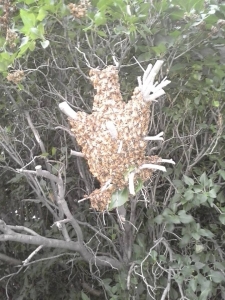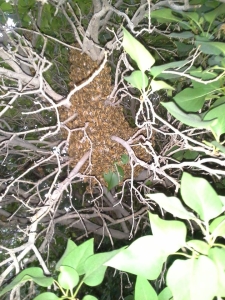Swarming is a honey bee colony’s method of reproduction. Most commonly occurring in spring, the old queen and approximately half of her workers leave the current nest and fly off in search of a new home in which to build a nest. Scouts fly around the general vicinity of the old nest in their search for a new suitable location. Their new home requires an adequate cavity in which to build as well as a sheltered entrance. Although the scouts start the search before the swarm vacates their old nest, a new location is often not found prior to the swarm occurring. This leaves the honey bees with the challenge of finding a location in which the swarm can rest until a location is found. The task of finding a resting place is the responsibility of a few of the worker bees, referred to as “leader bees”. When a location has been determined, they secrete a pheromone that attracts the queen and the other workers to the site. Swarms both in flight and while resting have a tendency to scare many people although they are fairly docile during this time. When clustered in a resting place, the queen is protected by her workers, who if disturbed will defend their queen. Scout honey bees are charged with flying to and from the cluster collecting nectar to keep the other honey bees hydrated and energized. Beekeepers are typically available to remove clusters of honey bees, especially in the spring time when the bees will have ample time to establish their colony within a hive box. Left alone, swarms will typically vanish in 1-2 days when a nesting location has been found.
Swarm Dos:
- Keep clear of the area in which the cluster is resting. If necessary, rope off or otherwise post notice in the area to prevent the cluster from being disturbed which may result in the honey bees acting in a defensive manner. This includes pets are dogs and cats are likely to be stung while biting at or swatting the flying bees. Their natural curiosity often draws them to the buzzing ball of activity. Leash walking pets to keep them out of the area is best until the bees have moved on.
- Contact a local bee keeper to retrieve the honey bees. They will need information on how high the swarm is, how long it has been there and any potential obstructions or obstacles that may need to be dealt with in order to access the cluster.
Swarm Don’ts:
- Spray the swarm with water or chemicals. Water will anger the cluster and you will likely get stung multiple times in the process. Bees that have been sprayed with chemicals are of no worth to bee keepers. Dead bees that have been chemically killed should be cleaned up and disposed of to avoid exposure to non-target animals such as birds that may consume the dead honey bees.
- Attempt to remove the swarm yourself. Removal is best completed by an experienced professional wearing personal protective equipment.
Local bee keepers can often be located by contacting bee keeping associations. Here are links to a few of the many associations in Colorado:
https://coloradobeekeepers.org/ – Colorado Beekeepers Association
https://nocobees.org/ – Northern Colorado Beekeepers Association
http://www.pikespeakbeekeepers.org/ – Pikes Peak Beekeepers Association

